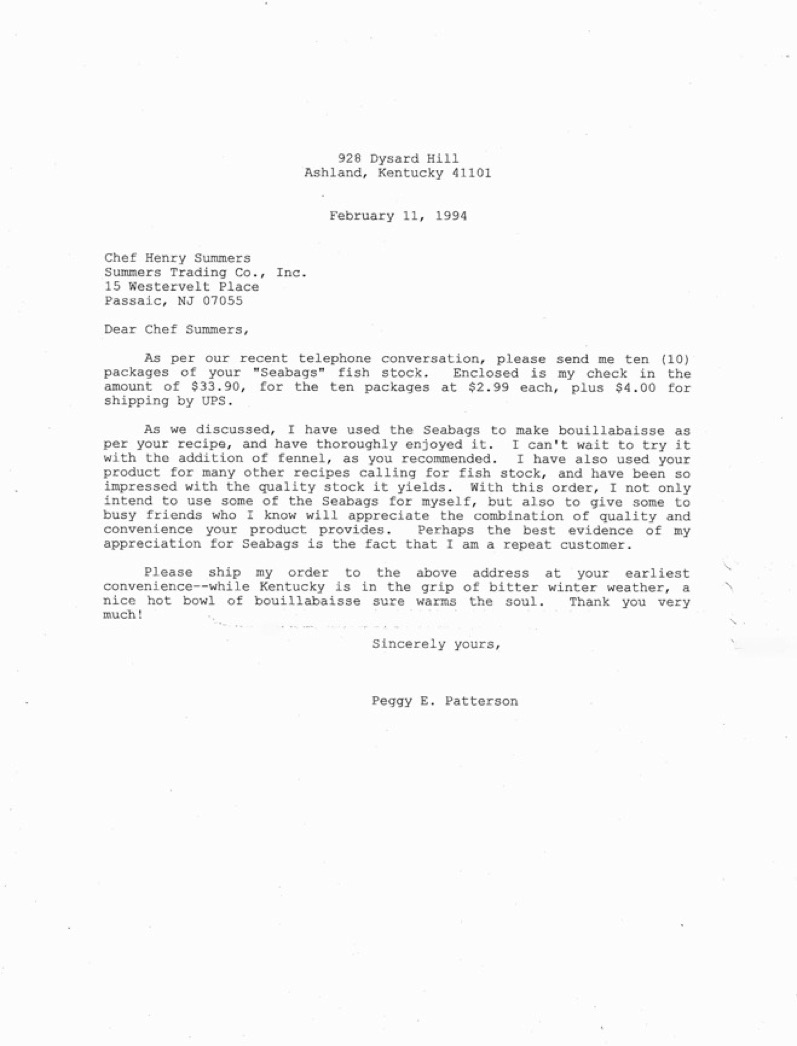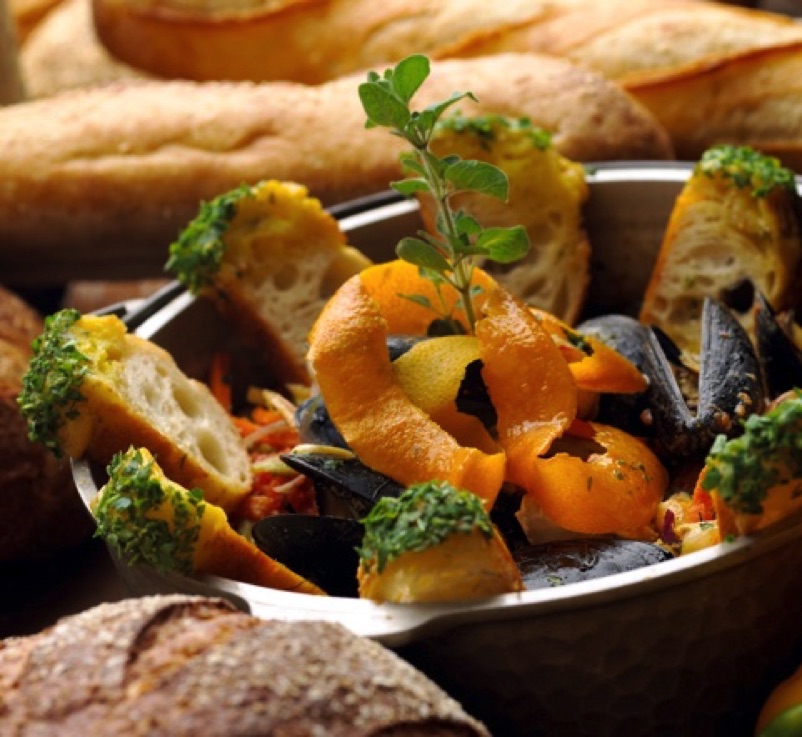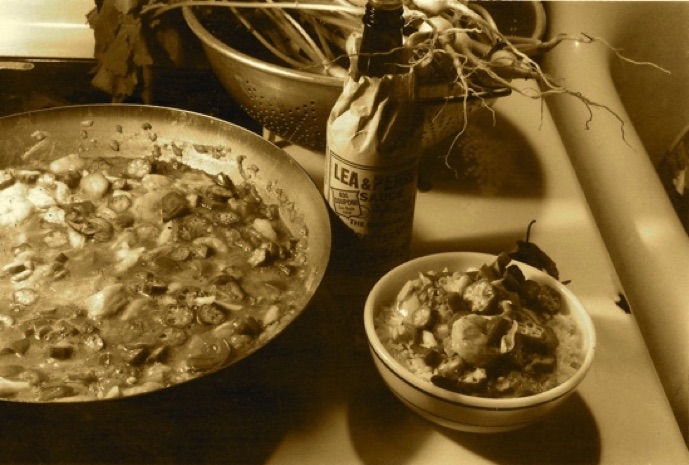
Created and styled by Chef Henry M, Summers, photographed in 4" x 5" film by Jim Lord
The word gumbo is derived from the South- and Central-African word for okra, a vegetable that was brought to America aboard the slave ships. The world-famous Créole stew, therefore, is rooted in African cooking.
The brown roux called for as a thickener in most gumbo recipes reflects the influence of classically-trained French cooks in the Créole kitchen. Unlike roux blond (see sauce velouté, above), cooking a roux to the brown stage is a long and tedious process, during which it must be frequently stirred and constantly monitored so it doesn’t burn.
Historically, however, ground peanuts have been used for centuries to enrich and thicken all sorts of savory stews in sub-Saharan Africa. Using peanuts in this manner, then, is highly appropriate in what is, in essence, an African dish.
Ingredients
1/4-cup (4 tablespoons) Seabags Instant Fish Stock
1 cup smooth peanut butter, preferably ground from fresh peanuts without sugar added,
but commercial brands may be used in a pinch
3 cups cold water
1 cup dry white table wine
3 tablespoons peanut or vegetable oil
2 cups okra, fresh or frozen, sliced in 1/2” pieces
2 cups celery, cut across 1/4” to 1/3” thick
2 cups green bell pepper, cut in 1/2” dice
2 cups scallions, white and green, chopped
2 or 3 cloves of garlic, minced
14 ounce can of diced tomatoes
1 teaspoon of Worcestershire sauce, or more to taste
1/2 teaspoon Tabasco or other bottled hot sauce, or more to taste
1 pound raw shrimp, peeled and deveined, defrosted if frozen
black pepper to taste
salt to taste if desired
4 cups cooked long-grain rice, hot
Method
Combine the SeaBags with the water and wine, and bring to a simmer. Add the peanut butter, and whisk until smooth.
Place a separate 5- to 6-quart heavy-bottomed saucepan over medium heat. Add the oil, then the scallion, garlic, celery, green pepper and okra. Stir the vegetables until wilted.
Add the tomatoes and stock. Bring to a simmer. Add salt, pepper, Worchestershire and hot sauce, all to taste. After 15 or 20 minutes of simmering, add the shrimp. They will cook very quickly–as soon as they are opaque, they will be done. Do not overcook! Taste, addig more salt, pepper, Worchestershire and hot sauce as desired.
Serve in bowls over rice, with a bottle of hot sauce to pass at table. Plenty of ice cold beer will keep the flames down to a steady smolder.
Risotto alla Seabags
The risotto technique for cooking rice is one of the crowning achievements of Italian gastronomy – and that, friends, is saying a mouthful. It differs from methods employed by every other rice-eating culture in two essential ways: the rice is stirred while it cooks; and the liquid is added gradually, with each new addition withheld until the previous one has been all but completely absorbed. This results in still-individual grains suspended in a creamy matrix – a totally different effect from the pilafs and pilaus that restaurants shamelessly attempt to fob off as the authentic article.
Risotto (plural risotti) is poorly suited to restaurant service. Rather, it belongs to the category of fine home cooking. It can’t be cooked ahead, rushed, or made to wait while an earlier party lingers over another round of espresso, anisette, and conversation.
Cultivated in Italy’s Po Valley since ancient times, roly-poly Arborio, Baldo, Carnaroli, and Violone make the most authentic risotti. An excellent alternative may be found in your supermarket’s Hispanic aisle – a medium-grain variety labeled typo blue rose, packaged under such brand names as Goya and Vitaroz. And conventional cookbook wisdom notwithstanding, Carolina and other New World long-grain varieties respond deliciously to the risotto treatment, too.
Of all risotti, those moistened with fish stock and garnished with fish and/or shellfish are the most delicate. While the following recipe calls for shrimp, feel free to use any seafood, alone or in combination, cut in bite-size pieces. When fresh or fresh-frozen seafood is unavailable, canned crab meat, clams, oysters, scungilli, shrimp, or even tuna may be utilized. The canning liquid, however, is best discarded, along with any tinny taste. Canned or frozen seafood should be lightly rinsed before use.
Ingredients
3 – 5 cups of prepared Seabags fish stock
2 or 3 tablespoons of extra-virgin olive oil
2 to 4 cloves of fresh garlic, thinly sliced or finely chopped
1 cup of raw rice (see comments above)
1 cup dry white table wine
1 pound of raw shrimp, shelled and deveined, in bite-size pieces (see comments above)
2 tablespoon additional extra-virgin olive oil (optional)
1 1/2 teaspoons salt, or to taste (optional)
hot pepper flakes to taste (optional)
black pepper to taste
parsley, freshly chopped, for garnish (optional)
Method
Place the oil and garlic over low heat in a heavy-bottomed saucepan. When the garlic just begins to color, add the rice, and stir for a few minutes until all the grains are well coated.
Add the wine, raise the heat to medium, and stirring gently, cook until the wine has almost evaporated. Then begin adding the hot fish stock a 1/2 cup at a time, allow it to be absorbed by the rice until adding the next 1/2 cup. Continue to stir gently all the while, making sure that the rice doesn’t stick and burn to the bottom of the pot.
Continue adding stock until the rice is cooked, but still slightly firm. On average, the cooking should be completed in between 20 and 30 minutes. When cooked correctly, the rice should still be moist enough to ripple slightly – what the Italians call undulante. Fold in the raw shrimp or other seafood, and cover for 10 minutes. It will be cooked to perfection by the heat retained by the rice.
Consider serving a Recioto di Soave Superiore DOCG – might as well make it a Riserva.
Note: In Italy, combining seafood with cheese evokes disgust and horror. This is a mystery to the French and other Europeans who do it all the time without ill effects. However, if you find yourself in Venice, and request Parmesano-Reggiaino for your seafood risotto, don’t say Chef Henry didn’t warn you.
Bouillabaisse
Created and styled by Chef Henry M. Summers, detail of photo by Jeff Goldman
The word bouillabaisse is a contraction of two French verbs: bouillir, meaning ‘to boil,’ and abaissar, meaning ‘to abate, or die down.’ Bringing the bouillabaisse to a boil 3 times causes the oil and broth to emulsify into a sauce. Roux is never used to thicken a bouillabaisse.
Like many top-ticket menu items, bouillabaisse has its origins in the culinary coping skills of the poor. Its composition was determined by whatever small fish and odd bits remained of a fisherman’s catch after the more desirable specimens had been sold.
The kinds of fish and shellfish that went into the pot, then, were constantly changing. The arguments made by some Francophiles over the indispensability of weever, racasse, or some other bony little rock fish are, it seems to me, missing the boat.
Olive oil, tomatoes, garlic and saffron, however, are essential, because they set bouillabaisse apart from the innumerable other fishermen’s stews found beside every quay. Typically, orange peel, as well as fennel, anise or tarragon, contribute to bouillabaisse’s characteristic savor. Of course, a good, flavorful fish stock gives you a big leg up in the matter.



Click the dog fish puppy, and go to
MORE MAIN DISHES
Shrimp Gumbo, c. 1983 by Chef Henry M. Summers
